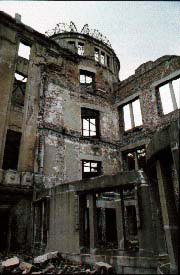Atomic Bomb Dome Registered as World Heritage
Hiroshima's pledge becomes humanity's pledge

On December 5,1996, the UNESCO World Heritage Committee meeting in Merida, Mexico decided to register the Atomic Bomb Dome on the World Heritage List. A symbol of Hiroshima's pledge to abolish nuclear weapons and seek lasting peace, the Atomic Bomb Dome entered the 21st century as a legacy common to the entire human race.
Wide-spread support for Atomic Bomb Dome
The drive to register the Atomic Bomb Dome as a World Heritage gained significant momentum in 1992 when Japan signed the World Heritage Convention. Responding to public pressure, the Hiroshima City Council adopted in September 1992 a resolution to pursue registry of the Dome on the World Heritage List, which turned the effort into a full-scale campaign. In January 1993, Hiroshima's mayor formally requested that the national government recommend to UNESCO that the Atomic Bomb Dome be registered as a world heritage.
In June, the Committee to Promote the Atomic Bomb Dome as a World Heritage was formed, receiving broad-based support from citizens' groups. This committee then launched a nationwide signature drive. A petition to the Diet accompanied by these signatures was adopted in 1994 by plenary sittings in both houses. The petition was signed by over 1.65 million people calling for the Dome to be recognized as a world heritage.
Before a country can nominate a site as a world heritage, the site must be protected as a historical asset under domestic law (buildings and other cultural assets in Japan must be protected under the Cultural Asset Preservation Law). In 1994, the Atomic Bomb Dome had not as yet been designated a cultural asset under that law. Furthermore, the national government's position was that the Dome was not old enough to qualify as a historical site. However, thanks to efforts by numerous supporters, the Agency for Cultural Affairs revised in March 1995 the basic criteria for historical site designation under the Cultural Asset Preservation Law, and in June designated the Atomic Bomb Dome a national historic site. In September, the national government formally recommended to UNESCO that the A-bomb Dome be registered as a world heritage.
In advance of this nomination, Hiroshima City established a beautification zone around the Atomic Bomb Dome and Peace Memorial Park designed to create an environment more suitable for a world heritage.
After the nomination, the Dome was evaluated by the World Heritage Committee, and on December 5, 1996, the hopes of many people around the world were fulfilled when the Atomic Bomb Dome was accepted for registry on the World Heritage List.
A symbol in Japan and abroad
The Atomic Bomb Dome, standing as a silent witness to the tragic history of humankind's first use of an atomic bomb, is a precious legacy of universal value. Its registry on the World Heritage List is international recognition of this value and an indication that the human community is developing a common awareness that nuclear weapons must never be used again. The profound significance of the Dome's registry as a world heritage is etched in the hearts of our people, and Hiroshima City intends to continue its efforts to publicize the Atomic Bomb Dome here at home and abroad as a symbol of our pledge to pursue lasting peace and the abolition of nuclear weapons.
